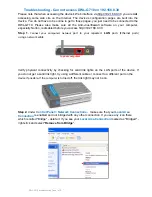
565
Configuring Network Security with ACLs
Configuration Examples for Network Security with ACLs
Routed ACLs: Examples
shows a small networked office environment with routed Port 2 connected to Server A, containing
benefits and other information that all employees can access, and routed Port 1 connected to Server B, containing
confidential payroll data. All users can access Server A, but Server B has restricted access.
Use router ACLs to do this in one of two ways:
Create a standard ACL, and filter traffic coming to the server from Port 1.
Create an extended ACL, and filter traffic coming from the server into Port 1.
Figure 75
Using Router ACLs to Control Traffic
This example uses a standard ACL to filter traffic coming into Server B from a port, permitting traffic only from
Accounting’s source addresses 172.20.128.64 to 172.20.128.95. The ACL is applied to traffic coming out of routed Port
1 from the specified source address.
Switch(config)#
access-list 6 permit 172.20.128.64 0.0.0.31
Switch(config)#
end
Switch#
show access-lists
Standard IP access list 6
permit 172.20.128.64, wildcard bits 0.0.0.31
Switch(config)#
interface GigabitEthernet1/17
Switch(config-if)#
ip access-group 6 out
This example uses an extended ACL to filter traffic coming from Server B into a port, permitting traffic from any source
address (in this case Server B) to only the Accounting destination addresses 172.20.128.64 to 172.20.128.95. The ACL
is applied to traffic going into routed Port 1, permitting it to go only to the specified destination addresses. Note that with
extended ACLs, you must enter the protocol (IP) before the source and destination information.
Switch(config)#
access-list 106 permit ip any 172.20.128.64 0.0.0.31
Switch(config)#
end
Switch#
show access-lists
Extended IP access list 106
Server A
Benefits
Server B
Payroll
Port 2
Port 1
Accounting
172.20.128.64-95
Human Resources
172.20.128.0-31
101354
Summary of Contents for IE 4000
Page 12: ...8 Configuration Overview Default Settings After Initial Switch Configuration ...
Page 52: ...48 Configuring Interfaces Monitoring and Maintaining the Interfaces ...
Page 108: ...104 Configuring Switch Clusters Additional References ...
Page 128: ...124 Performing Switch Administration Additional References ...
Page 130: ...126 Configuring PTP ...
Page 140: ...136 Configuring CIP Additional References ...
Page 146: ...142 Configuring SDM Templates Configuration Examples for Configuring SDM Templates ...
Page 192: ...188 Configuring Switch Based Authentication Additional References ...
Page 244: ...240 Configuring IEEE 802 1x Port Based Authentication Additional References ...
Page 298: ...294 Configuring VLANs Additional References ...
Page 336: ...332 Configuring STP Additional References ...
Page 408: ...404 Configuring DHCP Additional References ...
Page 450: ...446 Configuring IGMP Snooping and MVR Additional References ...
Page 490: ...486 Configuring SPAN and RSPAN Additional References ...
Page 502: ...498 Configuring Layer 2 NAT ...
Page 770: ...766 Configuring IPv6 MLD Snooping Related Documents ...
Page 930: ...926 Configuring IP Unicast Routing Related Documents ...
Page 976: ...972 Configuring Cisco IOS IP SLAs Operations Additional References ...
Page 978: ...974 Dying Gasp ...
Page 990: ...986 Configuring Enhanced Object Tracking Monitoring Enhanced Object Tracking ...
Page 994: ...990 Configuring MODBUS TCP Displaying MODBUS TCP Information ...
Page 996: ...992 Ethernet CFM ...
Page 1066: ...1062 Using an SD Card SD Card Alarms ...
















































